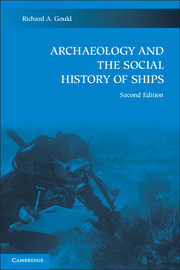Book contents
- Frontmatter
- Contents
- List of figures
- List of tables
- Acknowledgments
- Introduction: Toward a higher standard
- 1 Interpreting the underwater archaeological record
- 2 Underwater archaeology: The state of the art
- 3 Ships and shipwrecks: Basic mechanics
- 4 The archaeology of small watercraft
- 5 The earliest ships
- 6 Shipwrecks and our understanding of ancient trade
- 7 Sailing ships of the Middle Ages
- 8 Ships of the great age of sail
- 9 From sail to steam in maritime commerce
- 10 New technologies and naval warfare
- 11 The archaeology of maritime infrastructure
- 12 The future of shipwreck archaeology
- References cited
- General index
- Ship and site index
12 - The future of shipwreck archaeology
Published online by Cambridge University Press: 05 June 2012
- Frontmatter
- Contents
- List of figures
- List of tables
- Acknowledgments
- Introduction: Toward a higher standard
- 1 Interpreting the underwater archaeological record
- 2 Underwater archaeology: The state of the art
- 3 Ships and shipwrecks: Basic mechanics
- 4 The archaeology of small watercraft
- 5 The earliest ships
- 6 Shipwrecks and our understanding of ancient trade
- 7 Sailing ships of the Middle Ages
- 8 Ships of the great age of sail
- 9 From sail to steam in maritime commerce
- 10 New technologies and naval warfare
- 11 The archaeology of maritime infrastructure
- 12 The future of shipwreck archaeology
- References cited
- General index
- Ship and site index
Summary
The most serious challenge to shipwreck and underwater archaeology today is counteracting the effects of treasure-hunting. These effects are both direct and indirect. The direct ones have to do with the destruction of submerged archaeological sites, and the indirect ones arise from the confusion created by the appropriation of the techniques of underwater archaeology for profit instead of preservation.
Author Peter Benchley (1989: 74) celebrates the joys of finding and taking objects from shipwrecks in Bermuda as follows:
Have you ever lain on the bottom in a sand hole, surrounded by ancient timbers, let some seawater trickle past your mouthpiece and tasted something wondrous and exotic and suddenly realized that what you were tasting was 300-year-old cedar? It is a taste so rich, so redolent of yore, that you can imagine yourself standing on the quarterdeck, can feel the roll of the sea beneath your feet, can hear the slap of canvas and the thunder of cannon.
However romantically phrased, the approach advocated by Benchley and others is entreprenurial, aimed at increasing the sale value of artifacts recovered from shipwrecks whenever possible. Behar (1986) and Wilkinson (1991) warn investors to regard treasure-hunting schemes as high-risk ventures with little likelihood of profit, pointing to a tendency for otherwise rational people to make irrational decisions when it comes to investments of this kind. The best litmus test for distinguishing treasure-hunting from archaeology is to see what happens to the materials after they are recovered.
- Type
- Chapter
- Information
- Archaeology and the Social History of Ships , pp. 336 - 356Publisher: Cambridge University PressPrint publication year: 2011



